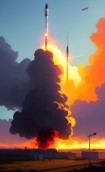|
doesnt magnesium burn under certain circumstances? I know pure it can flame up from being exposed to water. why would they use it for armor? the tale of the glomar explorer is awesome. Too bad they didnt get the whole sub. or did they
|
|
|
|

|
| # ? May 10, 2024 10:55 |
|
Raw_Beef posted:doesnt magnesium burn under certain circumstances? I know pure it can flame up from being exposed to water. why would they use it for armor? Its light-weight compared to steel. But it burns quite nicely I believe. Edit: Yep - http://en.wikipedia.org/wiki/BMD-1#Armour_protection
|
|
|
|
Raw_Beef posted:doesnt magnesium burn under certain circumstances? I know pure it can flame up from being exposed to water. why would they use it for armor? It's lightweight and reasonably strong. So, if you want an air-droppable APC to keep intermediate-cartridge small arms fire and shell fragments off of your paratroops it's a reasonable choice. It was even tested with parachuting some of the crew inside and it worked. Then you go and use it in an environment with IEDs, mines, and RPGs with shaped charge warheads. Now it is a flaming magnesium box that is impossible to extinguish or even approach and it is filled with burning diesel and screaming dying infantry. For that purpose, it was a poor choice. e, fb: The locator beacon approach described in the wikipedia article to unite dropped BMD-1s with their crews sounds like it would also act as a very effective way of summoning artillery through the magic of direction-finding. Frozen Horse fucked around with this message at 03:53 on Mar 29, 2012 |
|
|
|
Also, aluminum armor was used on Soviet APCs that followed.
|
|
|
|
My stepfather spent time in an M113 APC as well as a M551 Sheridan in 'Nam and discovered how much it can suck to be in an aluminum hulled armored vehicle.
|
|
|
|
priznat posted:They weren't supposed to go into combat with those tanks full of fuel either, I don't think. Yeah, I was thinking of the armored vehicle(s) where the crew/troops were essentially hosed if those tanks took fire.
|
|
|
|
In addition to the rear door fuel tanks, the BMP-1 and 2 also had an internal fuel tank. In the middle of the troop compartment. That the troops sat around.
|
|
|
|
True story: Soviet IFVs of the 1960s-era appear to have been designed for them by NATO.
|
|
|
|
I think most APCs/IFVs are basically rolling deathtraps if up against anything bigger than small arms fire.
|
|
|
|
priznat posted:I think most APCs/IFVs are basically rolling deathtraps if up against anything bigger than small arms fire. Command & Conquer 
|
|
|
|
My old platoon leader had a story about Russian airborne vehicles. It's a hell of a story, too. Apparently the crew doesn't jump along side the vehicle and join up with it later on the ground. Oh no. They ride in those fuckers all the way down. The officer gets a harness system and, I think, some padding in his compartment. The enlisted men get a lap belt and are told to brace themselves. Supposedly my PL heard this story from a Russian officer who was accompanied by his vehicle crew. Upon finishing the story, the officer said something to his men and, in response, they removed their berets to reveal identical scars on their scalps. Guess they didn't brace well enough.
|
|
|
|
Raw_Beef posted:doesnt magnesium burn under certain circumstances? I know pure it can flame up from being exposed to water. why would they use it for armor? For the same reason a company'd use magnesium alloy in a barbecue grille: it's lightweight. https://www.youtube.com/watch?v=bp4ucQCjNvU
|
|
|
|
movax posted:We have to remember that our desktop computers are designed for very nice, standard operation conditions. Sitting on the ground, 25C nominal, nice AC power, etc. In the electronics industry, we have several common "grades" of components: commercial, industrial, automotive, etc, with commercial generally being the cheapest. They vary my manufacturer, but commercial is usually slightly below 0C up to around 70 or 85C. Automotive grade components are IIRC -40C to either 85C or even higher. Industrial components can be -40C to 80C. Altera military grade components (Altera makes FPGAs, which they market heavily for radar applications) are listed as -55C to 125C. The exact numbers vary from maker to maker but I just want to explain there are different ranges for the same part, and this drives cost. One thing a lot of guys don't think of regarding military electronics is how much space they take up. There was a pic a few pages back of an F-105 with its brains pulled out and there's a poo poo ton of bulky, heavy boxes there. All that stuff makes heat, which then has to be dissipated, which takes more space. USN warships were notorious for not modernizing certain systems. Vacuum tubes were still around well into the '90s, and newer solid-state stuff was still mostly discrete components, with little use of integrated circuits. All very reliable, very easy to shield from mechanical shock and radiation attack, but bulky as all hell, and hot. On a ship where you're carrying duplicates of everything for spare parts, the spares take up tremendous space, space not used for food, crew or weapons, or to make the ship smaller and faster. The skills and equipment to make some of this stuff have essentially vanished from the US civilian market as well, so replacements are a hassle. Modernization and going to programmable, interchangeable (and OTS where possible) components doesn't just get you extra compute power. If the CPU board for your radar, sonar, nav and propulsion systems is the same part, you can probably get away with only carrying two or three spares on board instead of four or more. If one modern cabinet can hold the instrumentation that four used to, you can use that added space for more mission capability. So there's strong impetus to modernize even in apps that don't need tremendous compute power. The problem you get is the move from pure hardware dependability to hardware / software. It used to be that you made sure your parts could survive in the temp ranges, that the cabinets kept the environment out, that nothing acted as a ground or antenna or waveguide. Now you've got to check your code for bugs, memory leaks, etc., which is a heck of a lot harder than just microwaving your parts for radiation testing or smacking them with a hammer repeatedly to check for stress fractures. The skillsets are out there to both create bug-free code and to bugproof existing software, but it's not really a strength in the defense industry; for whatever reason they're stuck on thinking they sell heavy iron and not space calculators. The control problems with the F-35 don't sound CPU compute power related (with the possible exception of the helmet latency), they sound like bad programmers writing bad code. With inadequate bugproofing and bad bench-test routines, the only way this stuff comes out is by flying the planes around until they screw up.
|
|
|
|
I did a year of co-op work for a military contractor (now owned by general dynamics but who isn't) and dissipating heat from the CPLDs was a huuuuuuuuge issue. Especially when factoring in that everything had to be in sealed boxes that were resistant to moisture, dropping and NBC contaminants. It was an awesome job beating the poo poo out of that stuff for the most part. MIL-STD-810 stuff. Best one was the vibration table (that broke things spectacularly) and the worst was the fungus test because ew, nasty.
|
|
|
|
Same thing with space-borne systems. The Space shuttle relied completely on no-crew-kill code, and it resulted in stuff like 420000 lines of code containing one non-documented state. Do you know what corporation those developers worked for? Lockheed Martin - they originally worked for an IBM division sold in 1994, though. http://www.fastcompany.com/magazine/06/writestuff.html?page=0%2C0
|
|
|
|
Why don't they just stick 32 laptops in the plane, run them all with the same inputs, and use the output of the majority that match? 
|
|
|
|
My rear end in a top hat would sure pucker up nicely if I was on top of a stack of burning chemicals and noticed 17 votes saying "increase thrust" and 15 saying "decrease thrust".
|
|
|
|
Sjurygg posted:My rear end in a top hat would sure pucker up nicely if I was on top of a stack of burning chemicals and noticed 17 votes saying "increase thrust" and 15 saying "decrease thrust". "We have not achieved consensus."
|
|
|
|
grover posted:Battleships used to use fuel tanks as ballistic protection, as they'd burn like the dickens, but did a great job of absorbing the initial explosion. Also that a flooded fuel tank destabilizes the ship less than a flooded "dry" compartment. I can see it backfiring when used in this way in vehicles, but a burning fuel tank beats the shell exploding inside of it. Doesn't always work that way though. *cough*Hood*cough*
|
|
|
|
Vincent Van Goatse posted:Doesn't always work that way though. *cough*Hood*cough* Hood wasn't a battleship. She was a battle cruiser. Armed like a battleship but armored like a cruiser. Bismark's shells came right through the deck where the armor was real light. But even battleships were vulnerable to that kind of attack. Look at Prince of Wales, Repulse (another battlecruiser), and most famously Arizona.
|
|
|
|
MA-Horus posted:Hood wasn't a battleship. She was a battle cruiser. Armed like a battleship but armored like a cruiser. Bismark's shells came right through the deck where the armor was real light. But even battleships were vulnerable to that kind of attack. Look at Prince of Wales, Repulse (another battlecruiser), and most famously Arizona. The battlecruisers that blew up mainly blew up from penetrating hits to the turrets, and the turret armor wasn't much different from that of a battleship. Hood was actually probably killed by a penetrating hit to her 12" belt, at the range she was hit at the angle of incoming shells to her deck was very, very low. Bomb hits to the deck weren't want killed Repulse. Repulse got hit by 5 torpedoes and capsized. Sjurygg posted:Same thing with space-borne systems. The Space shuttle relied completely on no-crew-kill code, and it resulted in stuff like 420000 lines of code containing one non-documented state. The sole impediment to unmanned Shuttle missions was that the flight control computers were incapable of deploying the landing gear. You need an astronaut sitting in the sit to hit the switch. Phanatic fucked around with this message at 16:10 on Mar 29, 2012 |
|
|
|
MA-Horus posted:Hood wasn't a battleship. She was a battle cruiser. Armed like a battleship but armored like a cruiser. Bismark's shells came right through the deck where the armor was real light. But even battleships were vulnerable to that kind of attack. Look at Prince of Wales, Repulse (another battlecruiser), and most famously Arizona. Of those only Arizona is a fair comparison because the others didn't sink from a magazine explosion. They were lost to overwhelming damage from air attacks and, in, the case of Prince of Wales, from a catastrophic structural failure (one of her propeller shafts wrenched itself loose after a torpedo hit and tore up her insides, which hosed up her engineering spaces and left her immobile). As for Hood, my point was her fuel tanks contributed to her sinking. Their outer walls are missing along the side of the ship where the explosion (that started, as you said, at a place just beyond where her deck armor had been thickened during an overhaul, although whether she was hit by a plunging shell or a low-angle one is still debated) went straight through them to her bow and detonated the forward magazines. Vincent Van Goatse fucked around with this message at 16:14 on Mar 29, 2012 |
|
|
|
jwoven posted:In addition to the rear door fuel tanks, the BMP-1 and 2 also had an internal fuel tank. In the middle of the troop compartment. That the troops sat around. The doors weren't that much of an issue.
|
|
|
|
atomicthumbs posted:Why don't they just stick 32 laptops in the plane, run them all with the same inputs, and use the output of the majority that match? That's exactly what several rad-hardened systems do; several of the processing units are run in triplicate and they "vote" on decisions.
|
|
|
|
atomicthumbs posted:Why don't they just stick 32 laptops in the plane, run them all with the same inputs, and use the output of the majority that match? Somehow I think it'd end up like the B-36's engines. "Well, let's see, we've got five true, seven false, four kernel crashes, two nonfatal exceptions, three hardware failures, and I think the rest are just flopping around loose in the avionics bay." movax posted:That's exactly what several rad-hardened systems do; several of the processing units are run in triplicate and they "vote" on decisions. One thing I've always wondered about these systems: how do they harden the component that actually handles the "voting?" It seems to me that it'd always be a single point of failure, which kind of defeats the whole exercise. Is it just given extra shielding and built on a bigger/more rad-resistant process?
|
|
|
|
It's time for a Kfir Post. Back in the late 60s and early 70s, Israel needed...well, everything: guns, tanks, planes, etc. At that point in time, France was Israel's greatest supporter, and Israel's air force was heavily comprised of French craft: the Mirage, the Ouragon bomber, and the Mystere. The Mirages in particular were used in the opening stages of the Six-Day War, which were a massive victory for Israel, but the war and the "War of Attrition" that followed resulted in the loss of some 50 Mirages. By this stage, diplomatic tides were ebbing, and France didn't particularly want to prop up Israel anymore. So Israel "acquired" the plans to the Mirage, with the goal of reverse-engineering. Depending who you ask, they were either helped along by Dassault staff, or else they pulled off the most audacious industrial espionage in history, snagging thousands upon thousands of pages worth of diagrams and blueprints. What they built was this fellow:  Meet the Kfir. It was never quite as successful as Israel wanted it to be, since the year after it entered service, Israel got some F-15s, and by the time of the 1973 Yom Kippur War, most of their air force was American-made planes. The Kfir, capable though it was, never stood a chance, and became destined for export. That's where I want to start my exploration.  Only three countries bought the Kfir: Colombia, Ecuador, and Sri Lanka. Pictured is a FAC (Fuerza Aerea Colombiana) Kfir, identified as "Cachorro de Leon," Lion Cub, the plane's Israeli nickname.  If it looks like this photo is very recent, that's because it is. The Kfir was not only active in the Ecuadorean air force until the 90s, but it was actually involved in a war between Ecuador and Peru during 1994: http://en.wikipedia.org/wiki/Cenepa_War It's extremely difficult to figure out what actually happened in that war, as both sides have differing accounts and claim kills that the other side denies, but it appears that an Ecuadorean Kfir did score an air-to-air kill on a Cessna A-37, and Peru claims to have shot down a Kfir two days later. I think it's amazing that in 1991, the United States was rolling into Iraq with F-117s and B-2s, while three years later Ecuador and Peru were duking it out with Kfirs and Korea-era Soviet helicopters.  Many of the exported Kfirs were modified with front canards, Rafale/Typhoon style. Now let's give a little bit of love to the Peruvian air force, who have obviously modernized somewhat since Cenepa:  If you scroll on back up and check out the first Kfir picture I posted, you'll notice some "ATAC" markings on the tail fin. ATAC is a civilian company, so small it doesn't even have its own Wikipedia page, which provides "airborne tactical training, threat simulation, and research and development." They still fly their Kfirs; just earlier this month, one was lost in an accident and the pilot was killed. It sounds like they basically contract to do the Dissimilar Air Combat Training at naval air stations around the United States.
|
|
|
|
After crawling around, on, and in a bunch of FSU BMPs, BTRs, and MBTs two days ago, I have decided that they were not designed for humans. I mean, I get that ergonomically, cold war era fighting vehicles aren't great on any side, but when your only option for troops to enter and exit the vehicle is a 2x2 foot square hole cut into the side about 3 feet off the ground, what the gently caress? I'm not a small guy, but neither am I particularly large. I'm about 70 or 71 inches and weigh just over 170 pounds. In many of the vehicles, it would have been impossible for me to close the hatch while sitting in the seats, even without any headgear or helmet on. the M113 is downright comfortable in comparison.
|
|
|
|
I think starting with the T-54/55 series, the Soviet tank corps had a height max of 5'5. OK, I have a tank question. Are MBTs today in the west made to be (relatively) cheap and mass producible? I know (thanks to my nerd hobby of scale modeling) that the Soviets were fairly obsessive about making tanks to certain costs, because they were going to mass produce the poo poo out of them. The T-72, especially, was like the tank that wal-mart built. So in a WW 3 scenario, did modern western tank designs (the M1, the Leopard 2, the Challenger) take into account mass-reproducibility, so production could be cranked up if needed?
|
|
|
|
When I worked for the mil contractor they had a bunch of vehicles like M155 and a Leopard 1 and I could barely fit my shoulders through the commander's hatch. And that was while contorting.. Definitely not a tall guy's game, armor.
|
|
|
|
Vincent Van Goatse posted:As for Hood, my point was her fuel tanks contributed to her sinking. Their outer walls are missing along the side of the ship where the explosion (that started, as you said, at a place just beyond where her deck armor had been thickened during an overhaul, although whether she was hit by a plunging shell or a low-angle one is still debated) went straight through them to her bow and detonated the forward magazines. When it became clear at the end of WWII that missiles and bombs were too powerful to armor against, cold-war tactics shifted abruptly to what we see today: minimal armor and emphasis on getting inside the kill chain to avoid getting hit in the first place. Ironically, this was pretty much the whole philosophy behind battlecruisers, but failed miserably because they were misused at Jutland, and saw their only advantaged- speed- obsolesced by fast battleships in WWII. grover fucked around with this message at 00:24 on Mar 30, 2012 |
|
|
|
TheNakedJimbo posted:It's time for a Kfir Post. Didn't the US buy a few Kfirs to use in aggressor training? I could swear I've seen pics of Kfir's in marine or air force markings. e. A quick googling says that 25 were leased from 85-89, some to the Navy and some to the Marines.
|
|
|
|
Mr. Despair posted:e. A quick googling says that 25 were leased from 85-89, some to the Navy...  quote:and some to the Marines.  I've never been able to find out if the ones that ATAC owns now are the ones that the USN/USMC leased, but it wouldn't surprise me.
|
|
|
|
Nebakenezzer posted:
The number one design priority for the Abrams was "crew survivability." It's the first tank in history where everything else took a back seat to that. The design priorities were: 1. Crew survivability 2. Target acquisition 3. Hit probability 4. Time to acquire-and-hit 5. cross-country mobility 6. Complementary armament 7. Equipment survivability 8. Crew environment 9. Silhouette 10. Acceleration/braking 11. Ammunition 12. Human factors (I'm not sure what that means but I expect it's stuff like "Can the crew fix poo poo when it breaks?") 13. Production 14. Range 15. Speed 17. Diagnostic aids 18. Growth potential 19. Support equipment 20. Transportability Note that "Production" and "Growth potential" are way, way down the list. I don't expect that other Western MBTs had exactly the same priority in design, but I think they're probably roughly similar. grover posted:Fuel tanks didn't contribute to Hood's sinking. Lack of armor is what contributed to her sinking. Not even the thickest armor on the ship could withstand a direct hit from one of Bismarck's 15" guns. There's plenty of armor, it's just not "armor worn," big hunks of metal to keep the bullets out. Modern ship design entails a huge amount of what's called "armor of form," it's designing the object to be resistant to damage that does occur. Shock-hardened systems, redundant fire-fighting systems, and so forth. Then there's mitigant armor, of which the USN's focus on damage control is a big part. CIWS and RAM are active armor. Check this poo poo out: back in 1991, in the Persian Gulf, the USS Princeton (a 9600-ton cruiser) struck a mine in 16 meters of water. The explosion sympathetically detonated a second mine about 350 yards away. Between the different shock components, the ship was twisted in all 3 axes; the bow, stern, and midships were basically all gyrating in circles but with no common axis. This does *very bad* things to ships, stuff like cracking 8"x10" steel I-beams, heaving the deck upward 20 degrees, separating 10% of the superstructure from the main deck, things like that. Her chill-water pipes were ruptured, so her combat systems overheated and shut down. Her hull wasn't holed, but she still started to flood through burst seams. Her port rudder was jammed. Damage control efforts got her weapons systems back online within two hours, letting her resume duties as the local AAW command vessel. She stayed on station for another 30 hours providing air cover for the minesweeping and recovery efforts before she was relieved and put under tow. There were only a few deaths. Modern ship design's the difference between the HMS Sheffield taking a single dud Exocet hit and sinking under tow and the USS Stark taking two of them and sailing home under her own power. And *that* ship shouldn't even have taken those two hits, people should have been court-martialed over that poo poo.
|
|
|
|
Phanatic posted:And *that* ship shouldn't even have taken those two hits, people should have been court-martialed over that poo poo. When did the Stark take a hit from an Exocet? I remember it getting attacked by al-Qaeda but not a missile. Edit: Nevermind. I confused it with the Cole. Oxford Comma fucked around with this message at 00:41 on Mar 30, 2012 |
|
|
|
Phanatic posted:Check this poo poo out: back in 1991, in the Persian Gulf, the USS Princeton (a 9600-ton cruiser) struck a mine in 16 meters of water. The explosion sympathetically detonated a second mine about 350 yards away. Between the different shock components, the ship was twisted in all 3 axes; the bow, stern, and midships were basically all gyrating in circles but with no common axis. This does *very bad* things to ships, stuff like cracking 8"x10" steel I-beams, heaving the deck upward 20 degrees, separating 10% of the superstructure from the main deck, things like that. Her chill-water pipes were ruptured, so her combat systems overheated and shut down. Her hull wasn't holed, but she still started to flood through burst seams. Her port rudder was jammed. Damage control efforts got her weapons systems back online within two hours, letting her resume duties as the local AAW command vessel. She stayed on station for another 30 hours providing air cover for the minesweeping and recovery efforts before she was relieved and put under tow. There were only a few deaths. And then HMCS Athabaskan to the rescue!  (A classmate's dad was tactical coordinator on one of the Sea Kings based on the Athabaskan at that time) (A classmate's dad was tactical coordinator on one of the Sea Kings based on the Athabaskan at that time)Pretty cool that after all the hull damage she got a refit and is still in service.
|
|
|
|
Phanatic posted:The number one design priority for the Abrams was "crew survivability." It's the first tank in history where everything else took a back seat to that. The design priorities were: This is all solid info, thanks. Also note that after the Stark was hit, we went the other way as far as mentality goes and downed a civilian airliner within an air corridor with its IFF on...
|
|
|
|
mlmp08 posted:This is all solid info, thanks. I got to tour the USS Vincennes when it was docked in Victoria! (several years after this incident) drat impressive ships.
|
|
|
|
Nebakenezzer posted:So in a WW 3 scenario, did modern western tank designs (the M1, the Leopard 2, the Challenger) take into account mass-reproducibility, so production could be cranked up if needed? To a certain extent, yes, but that was because the West had a flat out more advanced industry, so they could operate at a higher level of sophistication and still churn out Challengers by the dozen, while the Soviet philosophy was to have thousands of cheap as gently caress, maximum-bang-for-buck tanks such as the T-55, T-62 and T-72 supported by dedicated tank guards divisions with the much more capable, advanced and expensive T-64s and T-80s. Both of the latter were arguably the most advanced tanks in the world when they came out, it's just then you get early adopter syndrome - they were expensive as hell as a consequence. Meanwhile, because the West, especially from the mid-70's onward, had made huge advances in computer technology and materials science it was possible to make tanks that were somewhere between the two tiers of tank design for a cost that wasn't absurd (except Japan,
|
|
|
|
To further the CF-35 "controversy" the Canadian budget came out today and the DoD is subject to some not small cuts. Some of the language was interesting:quote:the government is committed to retiring the air force's aging CF-18 by "acquiring an affordable replacement."
|
|
|
|

|
| # ? May 10, 2024 10:55 |
|
slidebite posted:To further the CF-35 "controversy" the Canadian budget came out today and the DoD is subject to some not small cuts. Some of the language was interesting: What does Canada do that would require a replacement for the F/A-18? Or are the Hornets just so old that they're soon going to fall apart?
|
|
|






























